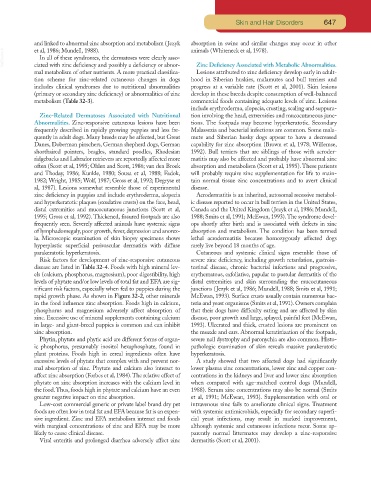Page 625 - Small Animal Clinical Nutrition 5th Edition
P. 625
Skin and Hair Disorders 647
and linked to abnormal zinc absorption and metabolism (Jezyk absorption in swine and similar changes may occur in other
VetBooks.ir et al, 1986; Mundell, 1988). animals (Whiteneck et al, 1978).
In all of these syndromes, the dermatoses were clearly asso-
Zinc Deficiency Associated with Metabolic Abnormalities.
ciated with zinc deficiency and possibly a deficiency or abnor-
mal metabolism of other nutrients. A more practical classifica- Lesions attributed to zinc deficiency develop early in adult-
tion scheme for zinc-related cutaneous changes in dogs hood in Siberian huskies, malamutes and bull terriers and
includes clinical syndromes due to nutritional abnormalities progress at a variable rate (Scott et al, 2001). Skin lesions
(primary or secondary zinc deficiency) or abnormalities of zinc develop in these breeds despite consumption of well-balanced
metabolism (Table 32-3). commercial foods containing adequate levels of zinc. Lesions
include erythroderma, alopecia, crusting, scaling and suppura-
Zinc-Related Dermatoses Associated with Nutritional tion involving the head, extremities and mucocutaneous junc-
Abnormalities. Zinc-responsive cutaneous lesions have been tions. The footpads may become hyperkeratotic. Secondary
frequently described in rapidly growing puppies and less fre- Malassezia and bacterial infections are common. Some mala-
quently in adult dogs. Many breeds may be affected, but Great mute and Siberian husky dogs appear to have a decreased
Danes, Doberman pinschers, German shepherd dogs, German capability for zinc absorption (Brown et al, 1978; Willemse,
shorthaired pointers, beagles, standard poodles, Rhodesian 1992). Bull terriers that are siblings of those with acroder-
ridgebacks and Labrador retrievers are reportedly affected more matitis may also be affected and probably have abnormal zinc
often (Scott et al, 1995; Ohlen and Scott, 1986; van den Broek absorption and metabolism (Scott et al, 1995). These patients
and Thoday, 1986; Kunkle, 1980; Sousa et al, 1988; Fadok, will probably require zinc supplementation for life to main-
1982; Wright, 1985; Wolf, 1987; Gross et al, 1992; Degryse et tain normal tissue zinc concentrations and to avert clinical
al, 1987). Lesions somewhat resemble those of experimental disease.
zinc deficiency in puppies and include erythroderma, alopecia Acrodermatitis is an inherited, autosomal recessive metabol-
and hyperkeratotic plaques (exudative crusts) on the face, head, ic disease reported to occur in bull terriers in the United States,
distal extremities and mucocutaneous junctions (Scott et al, Canada and the United Kingdom (Jezyk et al, 1986; Mundell,
1995; Gross et al, 1992). Thickened, fissured footpads are also 1988; Smits et al, 1991; McEwan, 1993).The syndrome devel-
frequently seen. Severely affected animals have systemic signs ops shortly after birth and is associated with defects in zinc
of lymphadomegaly, poor growth, fever, depression and anorex- absorption and metabolism. The condition has been termed
ia. Microscopic examination of skin biopsy specimens shows lethal acrodermatitis because homozygously affected dogs
hyperplastic superficial perivascular dermatitis with diffuse rarely live beyond 18 months of age.
parakeratotic hyperkeratosis. Cutaneous and systemic clinical signs resemble those of
Risk factors for development of zinc-responsive cutaneous severe zinc deficiency, including growth retardation, gastroin-
disease are listed in Table 32-4. Foods with high mineral lev- testinal disease, chronic bacterial infections and progressive,
els (calcium, phosphorus, magnesium), poor digestibility, high erythematous, exfoliative, papular to pustular dermatitis of the
levels of phytate and/or low levels of total fat and EFA are sig- distal extremities and skin surrounding the mucocutaneous
nificant risk factors, especially when fed to puppies during the junctions (Jezyk et al, 1986; Mundell, 1988; Smits et al, 1991;
rapid growth phase. As shown in Figure 32-2, other minerals McEwan, 1993). Surface crusts usually contain numerous bac-
in the food influence zinc absorption. Foods high in calcium, teria and yeast organisms (Smits et al, 1991). Owners complain
phosphorus and magnesium adversely affect absorption of that their dogs have difficulty eating and are affected by skin
zinc. Excessive use of mineral supplements containing calcium disease, poor growth and large, splayed, painful feet (McEwan,
in large- and giant-breed puppies is common and can inhibit 1993). Ulcerated and thick, crusted lesions are prominent on
zinc absorption. the muzzle and ears. Abnormal keratinization of the footpads,
Phytin, phytate and phytic acid are different forms of organ- severe nail dystrophy and paronychia are also common. Histo-
ic phosphorus, presumably inositol hexaphosphate, found in pathologic examination of skin reveals massive parakeratotic
plant proteins. Foods high in cereal ingredients often have hyperkeratosis.
excessive levels of phytate that complex with and prevent nor- A study showed that two affected dogs had significantly
mal absorption of zinc. Phytate and calcium also interact to lower plasma zinc concentrations, lower zinc and copper con-
affect zinc absorption (Forbes et al, 1984).The relative effect of centrations in the kidneys and liver and lower zinc absorption
phytate on zinc absorption increases with the calcium level in when compared with age-matched control dogs (Mundell,
the food.Thus, foods high in phytate and calcium have an even 1988). Serum zinc concentrations may also be normal (Smits
greater negative impact on zinc absorption. et al, 1991; McEwan, 1993). Supplementation with oral or
Low-cost commercial generic or private label brand dry pet intravenous zinc fails to ameliorate clinical signs. Treatment
foods are often low in total fat and EFA because fat is an expen- with systemic antimicrobials, especially for secondary superfi-
sive ingredient. Zinc and EFA metabolism interact and foods cial yeast infections, may result in marked improvement,
with marginal concentrations of zinc and EFA may be more although systemic and cutaneous infections recur. Some ap-
likely to cause clinical disease. parently normal littermates may develop a zinc-responsive
Viral enteritis and prolonged diarrhea adversely affect zinc dermatitis (Scott et al, 2001).

